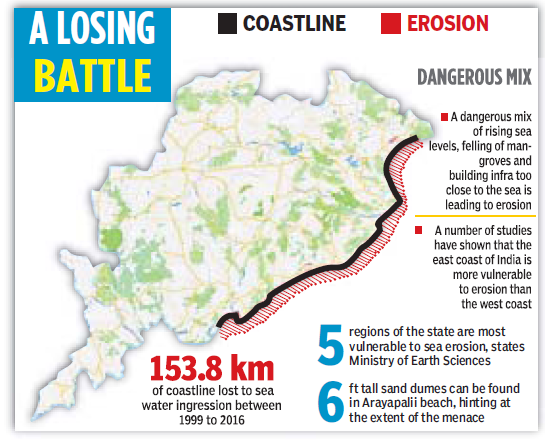Bhubaneswar: Odisha’s coast, home to the largest-known nesting site of the Olive Ridley sea turtle and Asia’s largest brackish water lagoon, is losing several metres of coastline every year due to artificial intrusion and climate change.
With several villages in the state either being completely engulfed by the sea or in the process, the fate of other coastal regions of the state hangs in balance. A number of coastal villages in Kendrapara, Ganjam and Puri are worst affected. Cut-off coastlines are now visible in many areas in these villages.
“Earlier, the sea was 500 metres away from the current coast. However, due to sea erosion, the coast continues to be engulfed by the sea. In the last six years, the situation has worsened. The government also tried to put some rocks along the coast but to no avail,” said Mattu Trinath, a fishermen from Arayapalli village in Ganjam district.
In Arayapalii, the phenomenon is most visible and rampant. Large sand cuts made by the sea are clearly visible in the coast where 6-ft tall sand dunes can be found, hinting at the extent of sea erosion in the area. In Podempatta area of the district, villagers were evacuated to a safer area by the government.
In Kendrapara district, several villages in Satabhaya were inundated by the sea and many of the villagers became climate refugees and were settled in villages like Bagapatia.
According to a 2018 report by the National Centre for Coastal Research in Chennai, the state lost 153.8 km (28 percent) of the 485 km-coastline to seawater ingression between 1999 to 2016. Reasons like rise in sea water and change in sea pattern were cited for the menace.
A reply given by the Ministry of Earth Sciences stated that it has identified five areas in Odisha as sea erosion prone. These include Ganjam Port North in Ganjam, Sahadabedi in Jagatsinghpur, Pentha, Satabhaya and Gahirmata in Kendrapara district.
The ministry also informed the Parliament that under the Integrated Coastal Zone Management Programme, shoreline management plans are being prepared for five stretches including Gopalpur to Chilka and Paradip to Dhamra coast among others.
Climate expert Ranjan Panda from Water Initiatives said, “Construction of ports and associated activities complimented with climate change factors lead to sea erosion in areas like Kendrapara district which needed urgent government attention.”
Meanwhile, the state government has attempted using geo tubes in areas like Pentha in Kendrapara and growing mangrove plants in coastal areas which are thought to be a lifeline for coastal areas as they prevent sea erosion.
Manish Kumar, OP

